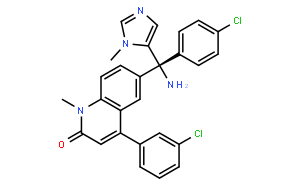
 COA COA |
 MSDS MSDS |
 HPLC HPLC |
 NMR NMR |
| CAS No: | 192185-72-1 |
| Molecular formula(MF) | C27H22Cl2N4O |
| Molecular Weight(MW): | 489.4 |
| Alias | (R)-6-(Amino(4-chlorophenyl)(1-methyl-1H-imidazol-5-yl)methyl)-4-(3-chlorophenyl)-1-methyl-2(1H)-quinolinone |
| In vitro | DMSO | 14 mg/mL (28.6 mM) |
|---|---|---|
| Water | <1 mg/mL | |
| Ethanol | <1 mg/mL | |
| In vivo | 15% Captisol+citrate vehicle | 5 mg/mL |
| Description | Tipifarnib (R115777) is a potent and specific farnesyltransferase (FTase) inhibitor with IC50 of 0.6 nM, its anti-proliferative effects are most prominent in H-ras or N-ras mutant cells. Phase 3. | ||
|---|---|---|---|
| Features | A potent and selective farnesyl protein transferase inhibitor with significant antitumor effects. | ||
| Targets |
|
||
| In vitro |
Using Tipifarnib 5 μM for 72 hours, the percentage of apoptotic cells is significantly higher in drug-treated compared to DMSO-treated LGL T-cells. Using T-cells from healthy donors, Tipifarnib reduces the percentage of IFNγ-positive cells in a time-dependent manner. Tipifarnib reduces the amount of activated Ras in precipitates compared to DMSO. [2] Tipifarnib exerts selective in vitro toxicity against clonal MDS hematopoiesis at concentrations less than 10 nM the effect being more prominent in white cell progenitors. This action is not due to apoptosis induction as both normal and MDS progenitors displays equivalent DiOC3 and annexin V expression up to 72 hours after exposure to Tipifarnib. [3] Combining Tipifarnib with 10 nM 4-OH-tamoxifen in the presence of E2 reduces the IC50 8-fold from 400 to 50 nM. [4] Tipifarnib induces apoptosis in U937 cells. [5] In addition, Tipifarnib inhibits isolated human farnesyltransferase for a lamin B peptide and for the K-RasB peptide with IC50 of 0.86 nM and 7.9 nM, respectively. [6] |
||
| In vivo | Ki-67 is lower in the tumors treated with E2 withdrawal plus R115777 compared with E2 withdrawal alone. The combination of tamoxifen and R115777 results in significantly lower Ki-67 compared with either tamoxifen or R115777 alone (mean of 5% versus 16.9% and 67.3%, respectively). [4] In contrast, no significant difference in apoptotic scores is seen between the treatment groups. R115777 alone also reduces the CTI compared with control. The combination of tamoxifen and R115777 or R115777 coupled with E2 withdrawal is most effective at lowering the CTI (0.8 and 0.7, respectively), which may account for the decrease in tumor volume. [4] |